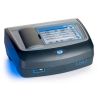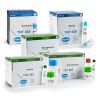Hach Phosphorus (Reactive and Total) TNTplus Vial Test
For determination of Reactive (ortho) and Total Phosphorus (phosphate) in wastewater, drinking water, boiler water, surface water and process water.
Features
- Easy and safe handling
- No reagent blank necessary
- Automatic method detection
- Expedited repair and warranty service
- Lifetime technical support
- More
Phosphorus TNTplus chemistry and your Hach spectrophotometer are engineered to simplify water analysis for accurate results, every time.
For determination of Reactive (ortho) and Total Phosphorus (phosphate) in wastewater, drinking water, boiler water, surface water and process water. TNTplus phosphorus reagents can provide an Orthophosphate or Total Phosphorus result.
Ascorbic Acid Method is Equivalent to EPA 365.1.
Phosphorus TNTplus chemistry allows you to test for reactive or total phosphorus with each vial. Follow the easy to navigate procedure printed on the lid of the box and then insert the TNTplus vial into your Hach spectrophotometer for an immediate result. Measurments are reported in the low range of 0.15 - 4.50 mg/L as PO4. If you are required to digest your phosphorus sample, performing this step in the sealed vial eliminates loss to evaporation and allows up to 30 simultaneous digestions depending on which DRB200 Reactor Block you are using.
Phosphates present in organic and condensed inorganic forms (meta-, pyro- or other polyphosphates) are first converted to reactive orthophosphate in the total phosphorus procedure. Treatment of the sample with acid and heat provides the conditions for hydrolysis of the condensed inorganic forms. Organic phosphates are also converted to orthophosphates in the total phosphorus procedure by heating with acid and persulfate. The reactive phosphorus procedure measures only the reactive (ortho) phosphorus present in the sample.
Phosphorus, Reactive (Ortho)
Phosphorus, Total
(0.15 - 4.5 mg/L PO₄)
In The News
Lake Erie Volunteer Science Network: Building Trust in Citizen Science Programs
Citizen science programs have popped up across the United States, focusing on connecting local communities with nearby water resources and building a trustworthy data pool over the sampling period. While commonly utilized as a means of ensuring that large watersheds or lake regions are adequately sampled, the credibility and success of such programs have been called into question. [caption id="attachment_38996" align="alignnone" width="940"] HRWC volunteers measure stream velocity across a subsection of Woods Creek, a tributary of the Huron River near Belleville, Michigan. Stream velocity measurements can be combined with water level measurements to calculate stream flow and chemical parameter loads.
Read MoreMonitoring Lake Erie’s Eastern Basin: Building Long-Term Data and Real-Time Public Solutions
In the eastern basin of Lake Erie, off the coast of Dunkirk, New York, a data buoy collects valuable water quality, weather, and wave data that inform residents and regulatory groups of conditions on the water. Since 2011, Buffalo State University’s Great Lakes Center has maintained and operated the Dunkirk buoy with funding from the Great Lakes Observing System (GLOS) and field support from the NYSDEC Lake Erie Fisheries Research Unit. [caption id="attachment_38976" align="aligncenter" width="940"] The Dunkirk Buoy viewed from the research vessel after being deployed in early spring.
Read MoreSonTek CastAway-CTD Meter Review
Lightweight and easy to use, the SonTek CastAway offers a convenient 3-in-1 solution for measuring conductivity, temperature, and depth profiles. At a 5 Hz sampling rate, the CastAway is designed for up to 1 m/s free-fall through the water column. With fast response and accurate conductivity, temperature, and depth measurements, the CastAway is ideal for thermocline and halocline profiling. The unit also reports salinity and speed of sound. [caption id="attachment_38732" align="alignnone" width="940"] Environmental scientist, Katelyn Kubasky, holding the SonTek CastAway in front of the pond at the Fondriest Center for Environmental Studies.
Read More










